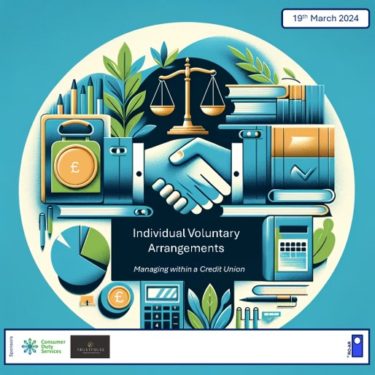
Date: 19th March 2024
Time: 10:00 – 11:30am
Summary
The discussion delved into the intricacies of Individual Voluntary Arrangements (IVAs), focusing on their impact within the credit union sector, challenges faced by creditors, and the evolving landscape of debt management.
The session brought to light the critical aspects of IVAs, including creditor perspectives, voting behaviors, and the broader implications on consumer financial health.
Key Points
- IVAs have seen fluctuating trends over the years, influenced by regulatory changes and market dynamics.
- Credit unions face unique challenges in managing IVAs, balancing member interests with financial sustainability.
- The voting behavior of creditors in IVA proposals shows a marked difference between credit unions and larger financial institutions.
- Recent regulatory changes and the introduction of consumer duties have significant implications for IVA management.
- Technology and digital solutions offer avenues to improve efficiency and outcomes in IVA processes.
- The role of insolvency practitioners (IPs) is critical in ensuring that IVAs serve the best interests of both debtors and creditors.
- Consumer understanding and engagement are essential for the success of an IVA.
- The impact of IVAs on consumer credit scores and future borrowing capabilities remains a concern.
- There is a need for greater transparency and accountability in the IVA process.
- Stakeholder education and collaboration are key to addressing the challenges associated with IVAs.
- The potential for IVAs as a debt solution varies significantly across different debtor circumstances.
- The webinar highlighted the importance of a data-driven approach to IVA management and decision-making.
Key Statistics
- The number of IVAs initiated annually and their success and failure rates.
- Percentage of IVAs approved by credit unions versus other creditors.
- Statistical trends in creditor voting behaviors over recent years.
- The impact of regulatory changes on IVA volumes and compositions.
- The proportion of IVAs containing homeowner debts and the outcomes.
Key Takeaways
- IVAs remain a complex yet vital tool for debt management, requiring careful consideration from all involved parties.
- Regulatory changes and consumer duties are reshaping the landscape of IVAs, demanding adaptability from creditors.
- Credit unions, with their unique position and challenges, play a crucial role in the IVA ecosystem.
- Technology and digital platforms offer promising solutions to improve the efficiency and effectiveness of IVA processes.
- Education and transparency are paramount in ensuring that IVAs achieve their intended outcomes for debtors and creditors alike.
- Stakeholder collaboration is essential in fostering a more equitable and effective IVA process.
- A data-driven approach can significantly enhance decision-making and outcomes in the management of IVAs.
- The success of an IVA hinges on a clear understanding and alignment of interests among debtors, creditors, and IPs.
- The webinar underscores the need for ongoing dialogue and research to address the evolving challenges of IVAs.
- Ensuring consumer protection and promoting financial health should remain central goals in the administration of IVAs.
- The diversity of creditor perspectives highlights the importance of tailored approaches to IVA management.
- Future developments in IVA regulation and practice must consider the balance between debtor relief and creditor rights.
RO-AR insider newsletter
Receive notifications of new RO-AR content notifications: Also subscribe here - unsubscribe anytime

